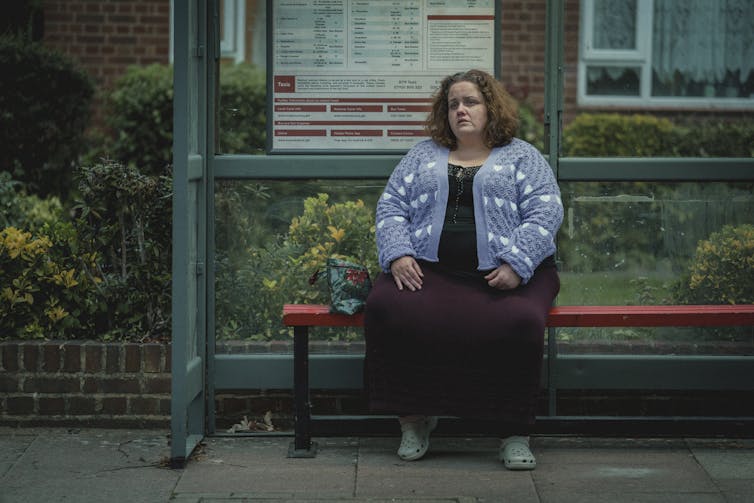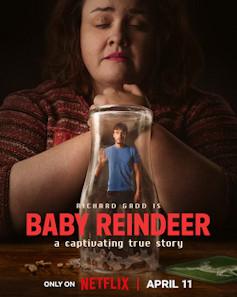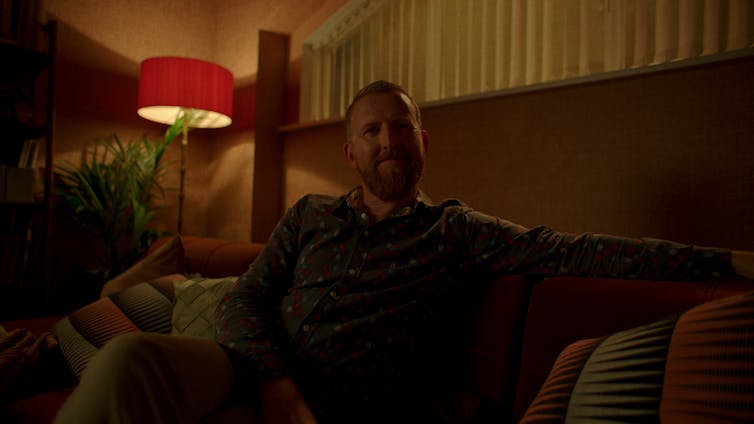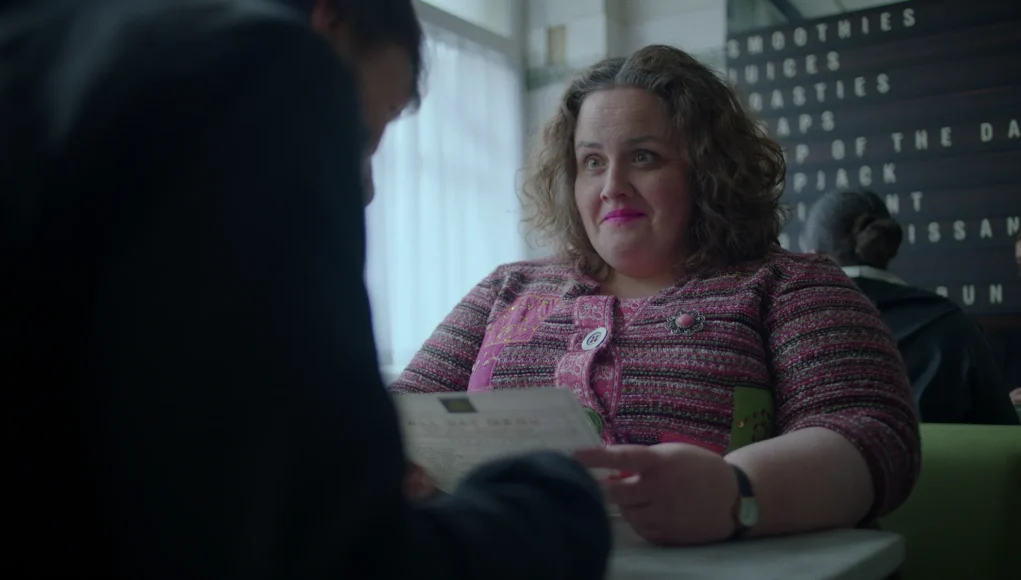By Alex Simpson, Macquarie University
Baby Reindeer’s phenomenal success has much to do with its writer and lead, Richard Gadd, who plays Donny in a tender semi-autobiographical account of sexual abuse, harassment and stalking. Gadd’s story has brought a fresh perspective on male victimisation, while giving a new voice for others to speak out.
At the same time, the show has set in motion a “horrible sort of sequel” as internet sleuths, with no small amount of help from pernicious media outlets, set out to expose the true identity of Martha.
This public outing is perhaps grimly predictable in an age of social media. But it raises questions of ethical standards among the show’s makers, and highlights how their portrayal of Martha conforms with – rather than challenges – well-worn and often misogynistic media representations of women offenders.
A woman walks into a bar
Baby Reindeer opens on Martha, played excellently by Jessica Gunning, walking into the pub where Donny (Gadd’s fictional version) is working to subsidise a stalling comedy career.
What starts off as a benign crush across the bar transforms into a torrent of daily contact. Over the course of seven episodes, Martha seeps into Donny’s most intimate spaces, and we see the insidious and relentless grip stalkers can have on victims.

Netflix
In criminology, feminist scholars show how the media taps into and magnifies deep-seated fears of deviant women, while paying much less attention to equally (if not more) serious male offending. In many ways Baby Reindeer is a case in point.
Martha’s character casts the longest shadow in the series, its publicity and the subsequent fallout. Speculation over her real identity that has been trending on social media for days, with Gadd even urging online sleuths to stop.

Netflix
Mad, bad and sad Martha
As a society, we’re fascinated by “monstrous women”. From the infamous Myra Hindley who murdered five children in the early 1960s with her husband, to Lucy Letby, a former neonatal nurse who was in the headlines last year for murdering seven infants, we have an unconscious fear of feminine evil.
It’s also perhaps dispiriting that we accommodate male offending into our expectations of masculinity. In doing so we perceive male offenders to be independent, rational, autonomous and responsible. In contrast, and as is the case with Martha, women offenders are viewed as dependent, emotional, irresponsible and not entirely adult.
While Gadd has drawn praise for his sympathetic treatment of Martha (indeed, Baby Reindeer could be read as an indictment of the United Kingdom’s mental health services) audiences are repeatedly reminded she is “clearly unwell”.
As with other media representations of female offending, we are quick to remove agency and trap women within a caricature of “mad, bad and sad”.

Netflix
Women who commit serious offences are already of news value by virtue of their relative rarity. But they become even more newsworthy when they can be further dehumanised by reference to their sexuality and/or appearance.
They are caught between media constructions of sex-craved promiscuity or cold isolating frigidity. They’re either conventionally unattractive, or a “femme fatale” who ensnares victims. We saw the latter in the media’s treatment of Amanda Knox, who was incarcerated in Italy following a wrongful conviction for the 2007 murder of Meredith Kercher. She was given the moniker “Foxy Knoxy”.
There’s a promotional picture from Baby Reindeer that illustrates a similar kind of pigeonholing. It shows Donny trapped in a glass, with an oversized Martha looming behind him.

Yet, in the show itself Donny is not shown as being so “trapped”. Rather, he chooses to engage with Martha time and again, and at times in questionable ways.
The internet starts a witch hunt
While Gadd has repeatedly claimed this is a fictionalised account of true events, many elements of Martha’s crimes were historically held in the public archive – from tweets she sent, to court documents and media articles.
It would be relatively easy for internet sleuths and journalists to put their fingers to keyboards to find the “real” Martha, as has reportedly been done. If this turns out to be true, then it’s clear the real Martha wasn’t afforded enough anonymity.
Meanwhile, Gadd says the identity of the other perpetrator – the powerful TV writer, Darrien, who grooms and repeatedly sexually assaults Donny – is an “open secret in the UK comedy scene”.
Donny acknowledges in the show:
there was always a sense that she was ill, that she couldn’t help it, whereas he was a pernicious, manipulative groomer.
Yet there is a protection afforded to the real Darrien – whether it be through power, means or gender – that isn’t in play for the real Martha. Martha is “unwell” and scraping by week-to-week in a council flat, while Darrien is top of the social ladder and living in affluence.

Netflix
As is often the case, Martha’s agency is diminished and she is subject to increased scrutiny, while the greater crimes committed by a man fail to garner the same media attention.
Raising the mirror
The challenge of balancing autofiction with anonymity isn’t new and Baby Reindeer won’t be the last such example. Fundamentally, however, this is less about fiction versus reality and more about how we, the viewers and the content makers, view female offenders.
Martha isn’t the person who groomed, repeatedly sexually abused Gadd and manipulated him into a drug habit, yet she is the centre of the show’s pitch and worldwide promotion. This raises more questions about our own ethics than anything else.![]()
Alex Simpson, Senior Lecturer in Criminology, Macquarie University
This article is republished from The Conversation under a Creative Commons license. Read the original article.







